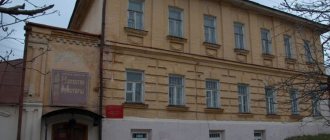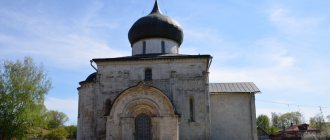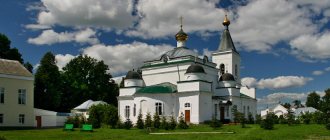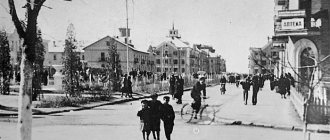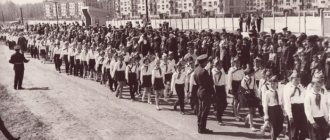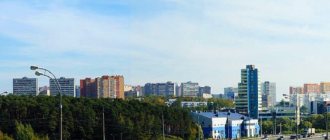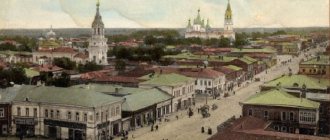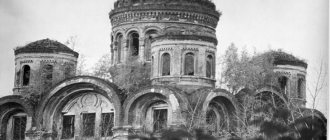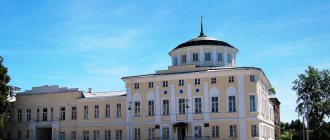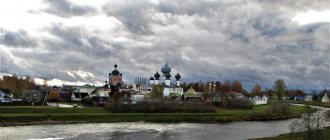In the Vladimir region there is a quiet and cozy place, included in the Golden Ring of Russia - the village of Bogolyubovo. The seemingly unremarkable territory contains many monuments of spiritual heritage and pleases the eye with incredibly beautiful landscapes.
People come here to recharge with positive emotions and learn a lot of interesting things about how our ancestors lived. The province of the Suzdal region, located on the coast of Klyazma, delights tourists with its special atmosphere. The village was once the residence of Andrei Bogolyubsky. After some time, a monastery appeared on the territory.
There are few attractions, the village is small. All sites are included in the UNESCO World Heritage List. Monuments of white stone architecture of the 12th century predominate. In summer there are many places for organizing outdoor recreation. The area is not crowded, so peace and quiet are guaranteed. You will definitely want to swim in Klyazma. The water is clean and clear. There are specially equipped sandy beaches on the territory of the village.
History of the settlement
The settlement was founded in 1158 by Prince Andrei Bogolyubsky. Under Prince Andrei, Bogolyubovo became a city with a permanent population, self-government, trade and crafts. At that time it served as the residence of the ruler. In those distant times, Rus' was very turbulent: wars and strife reigned all around. And in the midst of all this turmoil, Bogolyubovo was an island of calm and silence.
For seven years, construction work was actively carried out here: a church, a cathedral, a palace, and defensive structures were erected. It is interesting that stone was immediately used as a building material, while in other cities the first buildings of that time were predominantly wooden. Gradually, a fairly large settlement formed around the palace, which acquired permanent residents, local government, a settlement, and a militia. Trade and crafts actively developed here. As a result, the settlement received the de facto status of the capital of North-Eastern Rus'.
According to historical research, in the period before the Tatar-Mongol invasion, the settlement was surrounded by a double fortification (the inner contour was stone, the outer contour was wooden), inside of which the white-stone palace of Prince Andrei was located.
After the death of the Vladimir prince, development abruptly stopped. In 1177, the city was attacked and plundered by the Ryazan prince, as a result of which it suffered greatly. A century later, the defensive structures were destroyed as a result of the Mongol-Tatar invasion. In such conditions, the city could not develop successfully and lost its former significance. In the 17th-19th centuries, temple construction was actively carried out in the central part. The Bolsheviks who came to power closed the monastery in 1917. He returned to life only in the early 90s.
Despite all the hardships that befell it, the village has not lost its historical value, which only increases over time. The ditches, earthen ramparts, dilapidated white stone fortifications, the castle, the Church of the Nativity of the Virgin Mary (its basement part) and much more have been partially preserved to this day.
A little about the town
The ancient areas in Bogolyubovo are not affected by modern buildings. Therefore, director Tarkovsky gave the village the honor of playing the main role of a medieval village in his film. According to the cameramen, the panorama of the area has retained its medieval beauty.
However, the village of Bogolyubovo is extraordinary. A completely different town neighbors the ancient city - one-story log buildings with sheds, outbuildings, vegetable gardens and a population of just over four thousand. Life in it proceeds the same way as in any Russian outback. Most of the residential buildings in the village of Bogolyubovo are ancient, built at the beginning of the last century. The walls of the houses, although wooden, are so strong that it is impossible to drive a nail.
Attractions
The greatest value from a historical and architectural point of view is the Holy Bogolyubsky Convent, which was once part of the palace complex of Andrei Bogolyubsky. The building was erected on the site of the prince's chambers after his death as a symbol of atonement for sins. Today the monastery complex is considered the largest in central Russia. The slender architectural ensemble gives aesthetic pleasure, and the sculptural portrait of Prince Andrei, recreated from ancient casts and drawings, is of particular historical interest.
The Church of the Intercession on the Nerl deserves special attention, which is not only a striking landmark of Bogolyubov, but is also a true pearl of the Vladimir-Suzdal Nature Reserve, which includes the settlement. Tourists will also be interested in the palace of Prince Andrei Bogolyubsky, Bogolyubovsky Meadow, the railway station and other attractions of the city.
Memorials and monuments worth visiting in Bogolyubovo
Memorial signs reflect the history of the ancient settlement, reminding of the events through which it had to go, and the people who once lived on its land.
Monument to fellow countrymen who died during the Great Patriotic War
- Address: Monastery Garden.
In the garden of the Holy Bogolyubovsky Monastery there is a memorial dedicated to the memory of the soldiers - natives of the Bogolyubovsky rural settlement - who died on the battlefields of the Great Patriotic War. This is the only military monument in the village. It is a stone stele with a through five-pointed star. On the smooth surface of the monument are engraved the names of Bogolyubov who fell in battle.
Since 2016, the “Candle of Memory” campaign has been held at the site near the monument. Every year on the morning of June 22, villagers gather here to honor the memory of the victims of the Great Patriotic War. Also, ceremonial rallies in honor of Victory Day are organized at this place.
Old Bogolyubovskoye Cemetery
- Address: Ogurtsova street.
The old Bogolyubovskoe cemetery was founded more than two centuries ago. On its territory there are preserved stone crypts of merchants and nobles, ancient chapels installed on children's graves, wooden crosses at the burial places of clergy, as well as stone statues of patron saints.
The most famous grave of the cemetery belongs to Nikolai Vasilyevich Rakhcheev, a famous artist, music teacher and opera soloist. The monument to him is a stone slab with a granite plaque on which a portrait of the singer is engraved.
Palace and chambers of Prince Andrei Bogolyubsky
The chambers of the Grand Duke of Vladimir are a unique architectural monument of the 12th century.
Unfortunately, the palace has not been preserved, with the exception of only part of the buildings. The complex was built almost simultaneously with the Church of the Nativity of the Virgin. These are the first buildings that appeared on the banks of the Nerl River.
The Palace of Prince Bogolyubsky is the only civil building of pre-Mongol Rus' that has survived to this day and has been preserved at least partially.
The only fragments of the castle that have survived to this day are the gallery and the staircase tower, which became the site of the death of Andrei Bogolyubsky.
The prince spent 17 years in his country residence. Here in the summer of 1174 he was killed by his political opponents, the boyars Kuchkovich. The conspirators quietly snuck into the prince's bedroom and began beating him while he was sleeping. The traitorous servant stole the sword that was lying under the owner’s pillow in advance, which is why Andrei Bogolyubsky could not fight off his opponents. Deciding that the victim was finished, the conspirators left the crime scene. The prince remained alive, but at the moment when he was going down the stairs, he was noticed by a servant and thrown into the weeds.
Palace and chambers of Prince Andrei Bogolyubsky
The castle was considered lost for a long time. The fact that the princely chambers were located here became known by chance. In 1954, archaeologist N.N. Voronin discovered a spiral staircase that led to the tower, as well as a dilapidated passage to the Church of the Nativity of the Virgin. The temple formed a single complex with the castle, but now only the basement part remains of it.
The majestic beauty of the princely chambers can only be judged by ancient drawings and records. Thanks to N. Voronin's many years of work, the appearance of the princely castle ceased to be a secret. According to research, the princely palace was a two-story majestic building made of white stone, decorated with decorative carvings.
The palace was located on the banks of the Klyazma River, in the southern part of the city. From this place there was a wonderful view of the mouth of the Nerl River, which flowed into the Klyazma, nearby forests and the beauty of endless fields.
In addition to the palace and temple, the architectural ensemble included a stone ciborium and defensive walls. Palace buildings stretched in small groups around the square. The princely chambers were connected to the temple by arched passages with towers. Inside the latter there were spiral staircases, along which the prince, together with his entourage, could go directly to the church choir.
The cathedral, also built of white stone, was decorated with carved reliefs, copper tiles decorated with gilding, and stained glass windows. On the temple square there was a “holy tent” with the faces of the Mother of God, under which stood a bowl intended to consecrate water in memory of the appearance of the image of the Mother of God to the prince. The palace ensemble was surrounded by high (up to 6 meters) earthen ramparts, on which stood white stone walls and watchtowers.
Now the place of Andrei Bogolyubsky’s death is decorated with paintings depicting this terrible event. After the death of the prince, the palace was plundered, and at the beginning of the 13th century a monastery settled here. When, at the direction of the abbot, work began on expanding the windows of the temple, the monastery vaults could not stand it and collapsed. After some time, a new temple was founded on this site, and the two-tier tower with a gallery has since been part of the Bogolyubov Monastery. At the moment, a niche has been installed here in honor of Prince Andrei Bogolyubsky, who was canonized in the 18th century. In a niche there is a stone chair on which there are always fresh flowers.
Place of murder of Andrei Bogolyubsky
Address: st. Lenina, 51, territory of the Bogolyubsky convent.
Detailed information about this place can be found on the website of the Vladimir-Suzdal Museum-Reserve
Bogolyubovsky meadow
The attraction is a protected area of the city, in the center of which is the Church of the Intercession on the Nerl. The study of the territory began not so long ago - in the 60s of the 20th century. During research, three hundred rare species of rare flora were found here, some of which are listed in the Red Book.
Bogolyubsky Meadow often becomes a place for walks, but it is not always accessible for these purposes: during high water the area is heavily flooded, so you can only overcome the space by swimming. In such cases, it is suggested to rent a boat.
Bogolyubovsky meadow
Tourists and city residents can use two routes:
- Expensive for pedestrians. The path is paved with tiles, and along it there are souvenir shops. The path starts from the railway station.
- Ecological path. You can walk along it in spring and summer: this is when excursions are held here.
What to see in one day?
It will take a lot of time to walk around the entire church complex. Especially for those who only have a day to spare, we suggest visiting the following places that can be covered in a day:
- Bogolyubsky meadow. This is a landscape complex located near the Church of the Intercession on the Nerl. There are two routes - pedestrian and ecological.
- Railroad station Bogolyubovo. This station is made of wood and heated by a stove, which is now a rarity. It is located 10 km from Vladimir. City trains stop here.
- Confluence of the Klyazma and Nerl. The amazing confluence of two rivers creates a contrast of shades of water: somewhere it is darker, and somewhere light. It looks very unusual.
- Pedestrian bridge. The modern bridge at Bogolyubovo station passes over the railway tracks and provides convenient access to the meadow. You can go up the stairs or by elevator.
- Apiary at the Church of the Intercession on the Nerl. Near the church there is a small apiary. Church workers are engaged in beekeeping.
Bogolyubovo railway station
The station is located on the railway line connecting Moscow and Nizhny Novgorod, 10 kilometers from Vladimir. An old fence stretches around it. It is surprising that the wooden building is still heated by a stove. The appearance of the station has remained virtually unchanged since its inception.
Bogolyubovo railway station
How to get there?
regularly conducts trips to the cities of the Golden Ring of Russia.
Travel from Kazan
Travel from Cheboksary
Travel from Yoshkar-Ola
There will be no difficulties with how to get to a secluded corner of Russia. It is more convenient to travel from Vladimir. From here there are buses numbered 103, 18, 126, 152. They pass through the center and stop at Cathedral Square. Trolleybuses run from the station, and taxi services are offered. You can take trolleybus number 12 and get to the Chemical Plant, starting your route from here.
Many tourists prefer to travel by private car. Traffic will pass along the M7 highway. If you follow the signs, you will easily get to your final destination. It is necessary to pass through Vladimir and Nizhny Novgorod.
Railway communication has been developed. You can use the train. They depart from Vladimir and go to Kovrovo. Bogolyubovo is at the fourth stop.
Church of the Intercession on the Nerl
Date of construction: 1165. The temple is located at the confluence of the Nerl River and Klyazma. The hill on which the building rises is embanked. Around it stretch meadows, which are filled with the waters of the Nerl River every spring. For this reason, excursions to the temple are most often held in summer and autumn.
The building was erected quite quickly - in just one summer. The height of the church is about 21 meters.
There are several theories about what was the idea behind the construction of the temple. According to the first of them, the church was dedicated to the deceased son of Andrei Bogolyubsky, Izyaslav.
The second theory says that the temple was erected in honor of the prince’s victorious battles with the troops of Volga Bulgaria. The materials for construction were stones brought from enemy soil. It is generally accepted that this church was the first dedicated to the Feast of the Intercession of the Blessed Virgin Mary.
Church of the Intercession on the Nerl
In the 13th century, attempts were made to destroy the building in order to build a bell tower. However, the work stopped before it began. On the very first day, one of the craftsmen almost went blind: a grin got into his eye, and in order to restore his sight, the builder began to pray, his tireless requests lasting for many hours in a row. The ability to see returned to the master, and this miracle saved the church from destruction.
The beauty of the structure has been preserved to this day. You can observe it in the ancient stone decor in the form of lions and griffins, symbolizing princely power. In the exterior design of the building, among many drawings, you can see the image of King David. There is also a mask of the Virgin Mary. As for the interior, of all the decorations, only the carved altar has been preserved. Unfortunately, the 13th century frescoes did not stand the test of time and literally turned to dust.
Antique stone church decor
The water meadows for which the village is famous are part of the protected area.
The walls of the church conceal a mysterious spirit of antiquity, thanks to which interest in the architectural monument never fades.
Address: st. Vokzalnaya, 10. You can get from the village to the church on foot from the railway station (it’s not far, only 2 km). Another option is to travel by horse-drawn carriage or by boat (during high water).
Church of Joachim and Anna in Bogolyubovo
Construction of the temple was completed in 1857. If at first the building was located in the city center, now it stands near the Maskva-Ufa highway. It was no coincidence that the church received its name - Joachim was the father of the Virgin Mary, Anna was the mother. Construction lasted an unusually long time - as much as 50 years. In 1939 the church was closed, and soon it was completely destroyed. However, most of the building still survived: during the Soviet period it housed a cinema, then a warehouse and a store. In the 90s, when atheism ceased to be part of the state ideology, restoration work began, which, due to lack of funding, continues to this day.
Church of Joachim and Anna in Bogolyubovo
The Church of Joachim and Anna is often visited by married couples who pray for children.
Address: st. Lenina, 48. Opening hours: Monday – Sunday from 8:00 to 18:00.
Cathedral of the God-loving Icon
There are many beautiful churches in the Suzdal region. But the most interesting can rightfully be called the cathedral in honor of the God-loving icon of the Mother of God. It is considered to be the younger brother of the Cathedral of Christ the Savior, which is located in Moscow. Both buildings were built according to the design of the same architect, and some similarities can be seen in their features. The only thing that distinguishes them is the time of construction; the latter was built a little later.
The most unique feature of the temple is its heating system, which is still in operation today. It has no analogues. After the revolution, like most religious institutions, the temple was closed. But in 1985, restoration work began, which took a little longer and continues to this day.
Currently, the main achievement of the people working here is that they were able to completely restore the icon of the Bogolyubskaya Mother of God , which was painted back in the 17th century.
Bogolyubsky Monastery of the Nativity of the Virgin Mary
The Holy Bogolyubsky Monastery is one of the most beautiful and oldest religious buildings in Russia. The history of the temple is very interesting. As the legend says, Prince Andrei was carrying the icon of the Mother of God from Vladimir to Rostov, but after covering a short distance, the horses stood up and did not want to move. Then it was decided to stay here until the next day. At midnight, the Mother of God appeared to the prince and ordered him to build a temple of God in this place. Soon it was decided to found the Bogolyubo Monastery, and subsequently the city of Bogolyubovo itself. Initially it was a men's monastery. On the territory of the modern convent there are:
- Cathedral in honor of the Bogolyubsk Icon of the Mother of God. It is assumed that the building was built on the model of the Moscow Cathedral of Christ the Savior.
- Cathedral in honor of the Nativity of the Blessed Virgin Mary. Dating from the 12th century, it is a UNESCO World Heritage Site.
- Annunciation Church of the 17th century.
- Remains of the palace of Andrei Bogolyubsky.
- Gate bell tower. The height of the building is 58 meters.
- Chapel "Picturesque Spring".
- Holy gates.
- Chapel-ciborium. It was laid in the place where the appearance of the Mother of God to Andrei Bogolyubsky took place.
Many famous and significant people in history visited the walls of the monastery:
- Alexander Nevskiy. In 1263, the body of the Grand Duke, who died under strange circumstances, was brought here.
- Andrey Rublev. He often came to the monastery to pray before the icon of Our Lady of Bogolyubskaya.
- Alexander Suvorov.
- Dmitry Pozharsky.
- Ivan groznyj.
Bogolyubsky Monastery of the Nativity of the Virgin Mary
Like other religious sites, in the 30s of the 20th century the monastery was closed and destroyed. The building housed various institutions: a school, a hospital, a post office, and warehouses. Monastic life was revived only in 1997, when nuns from the Zadonsk Transfiguration Monastery came to the monastery.
There is a source of holy water on the territory of the temple.
Address: st. Lenina, 49.
Detailed information about this place can be found on the monastery website.
Holy spring
Near the monastery there is a holy spring. It is not easy to find, although there is a sign. To get to the source you need to walk along the monastery wall along the main street of the village, then turn right onto a small road, and after about 30 meters there will be a sign indicating that you are on the right to the source. Follow the path to the monastery wall, and then left along the wall. Soon you will see an iron staircase leading down to the source.
Chapel of the Icon of the Mother of God “Life-Giving Spring”
The structure is made of white stone. The blue roof of the chapel is hidden by dense tree crowns.
Chapel of the Icon of the Mother of God “Life-Giving Spring”
This is a relatively young building - built in 2001, located 2 kilometers from the Bogolyubsky Monastery. There are 2 fonts in the chapel: one of them is intended for nuns, the second for visitors. The keys can be obtained from the nurse on duty, who also gives a blessing for bathing. According to belief, anyone who bathes in the life-giving holy water will gain health in body and peace of mind.
Address: st. Lenina, 49. To get there, you need to go around the southern wall of the monastery and go down to the Klyazma River.
